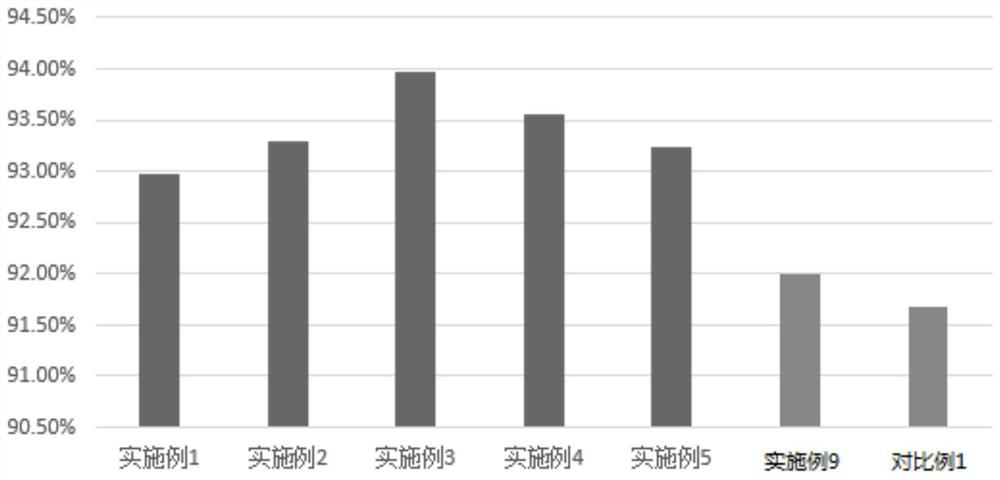Conductive agent and preparation method thereof, electrode and secondary battery
A technology of conductive agent and conductive network, used in secondary batteries, battery electrodes, circuits, etc., can solve problems such as lack of ionic conductivity
- Summary
- Abstract
- Description
- Claims
- Application Information
AI Technical Summary
Problems solved by technology
Method used
Image
Examples
preparation example Construction
[0047] Correspondingly, a preparation method of a conductive agent, comprising:
[0048] S01, dispersing the sulfonated graphene metal salt and carbon nanotubes in the solution, so that the sulfonated graphene metal salt and carbon nanotubes are combined to form a line-surface conductive network.
[0049] Wherein, the type selection and dosage ratio of the sulfonated graphene metal salt and carbon nanotubes in step S01 are basically the same as the above sulfonated graphene metal salts and carbon nanotubes. In order to save space, they are not repeated here. A repeat.
[0050] Specifically, the sulfonated graphene metal salt and carbon nanotubes are dispersed in the solution, so that the sulfonated graphene metal salt and carbon nanotubes combine to form a line-surface conductive network.
[0051] As an embodiment, the step of dispersing the sulfonated graphene metal salt and carbon nanotubes in the solution includes:
[0052] S011, mixing the sulfonated graphene metal salt ...
Embodiment 1
[0084] This embodiment provides a method for preparing a lithium-ion battery, which specifically includes the following steps:
[0085] 1) Preparation of mixed powder of sulfonated graphene lithium salt and carbon nanotubes
[0086] Choose sulfonated graphene lithium salt, the mol ratio of its sulfonate group and lithium is 1:1;
[0087] Select multi-walled carbon nanotubes;
[0088] According to the mass ratio of the sulfonated graphene lithium salt and the multi-walled carbon nanotubes being 1:5, the sulfonated graphene metal salt and the multi-walled carbon nanotubes were mechanically mixed and stirred for 90 minutes to obtain a mixed powder.
[0089] 2) Prepare mixed solution
[0090] Under vacuum conditions with an absolute pressure of 0.016MPa, according to the ratio of the mass ratio of hydroxymethyl cellulose to N-methylpyrrolidone of 1:94, the hydroxymethyl cellulose and N-methylpyrrolidone are rotated at a speed below 70°C Mix at 1200r / min for 60min to obtain a so...
Embodiment 2
[0096] This embodiment provides a method for preparing a lithium-ion battery, which specifically includes the following steps:
[0097] 1) Preparation of mixed powder of sulfonated graphene lithium salt and carbon nanotubes
[0098] Choose sulfonated graphene lithium salt, the mol ratio of its sulfonate group and lithium is 1:1;
[0099] Select multi-walled carbon nanotubes;
[0100] According to the mass ratio of the sulfonated graphene lithium salt and the multi-walled carbon nanotubes being 1:6, the sulfonated graphene metal salt and the multi-walled carbon nanotubes were mechanically mixed and stirred for 90 minutes to obtain a mixed powder.
[0101] 2) Prepare mixed solution
[0102] Under vacuum conditions with an absolute pressure of 0.016MPa, according to the ratio of the mass ratio of hydroxymethylcellulose to N-methylpyrrolidone of 1:94, the hydroxymethylcellulose and N-methylpyrrolidone are rotated at a speed below 70°C Mix at 1200r / min for 60min to obtain a solu...
PUM
| Property | Measurement | Unit |
|---|---|---|
| Radial size | aaaaa | aaaaa |
| Thickness | aaaaa | aaaaa |
| Tube chief | aaaaa | aaaaa |
Abstract
Description
Claims
Application Information
 Login to View More
Login to View More - R&D
- Intellectual Property
- Life Sciences
- Materials
- Tech Scout
- Unparalleled Data Quality
- Higher Quality Content
- 60% Fewer Hallucinations
Browse by: Latest US Patents, China's latest patents, Technical Efficacy Thesaurus, Application Domain, Technology Topic, Popular Technical Reports.
© 2025 PatSnap. All rights reserved.Legal|Privacy policy|Modern Slavery Act Transparency Statement|Sitemap|About US| Contact US: help@patsnap.com



